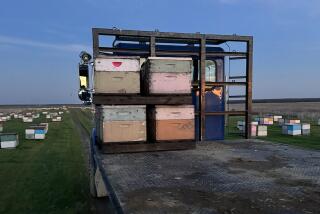Virus is called primary suspect in bee deaths
- Share via
Scientists have found a virus associated with the destruction of a large fraction of American commercial bee colonies, but they have not been able to prove that it is the cause of the mysterious disease that has wreaked havoc on the bee industry.
The virus, Israeli acute paralysis, may have been introduced by bees from Australia whose importation was first permitted in 2004, about the same time that the disease, Colony Collapse Disorder, or CCD, began appearing in the United States.
Australian bees do not suffer from the disorder, leading researchers to speculate that the virus interacts with chemicals in the environment or with another infectious agent, such as the varroa mite, which is not common in Australia.
Experiments are underway to determine which combination of virus and chemical or infectious agent might cause the disease, an answer that may come this year. Researchers are also examining archived bee specimens to determine whether the virus was present before 2004.
“Our results indicate that [the virus] is a significant marker” for the disorder, said Dr. W. Ian Lipkin of Columbia University’s Mailman School of Public Health, a co-author of the report published online Thursday by the journal Science. “The next step is to ascertain whether [the virus], alone or in concert with other factors, can induce [the disorder] in healthy bees.”
Entomologist May Berenbaum of the University of Illinois said the find was “compelling.”
But researchers from the Army’s Edgewood Chemical Biological Center in Maryland cautioned that they had unpublished results in which the Israeli virus had been found in colonies without the disorder.
Although the United States has experienced other bee die-offs, the latest episode has been one of the worst, affecting about 23% of beekeepers. Typically, 50% to 90% of a keeper’s colonies are affected as worker bees fail to return to their hives, leaving the queen with a handful of newborns.
Agricultural experts view the deaths with alarm because bees are required to pollinate about a third of the nation’s food crops, including almonds, cherries, pears, blueberries, strawberries and pumpkins.
The number of bee colonies in the country is about 2.5 million, half as many as in the 1940s and ‘50s.
“We don’t have a great deal of buffer” for dealing with bee losses, said entomologist Diana Cox-Foster of Pennsylvania State University.
In May, scientists from across the country formed a working group led by Cox-Foster and entomologist Jeffery S. Pettis of the U.S. Department of Agriculture to track down the cause of the deaths.
They enlisted virologist Lipkin to look for pathogens infecting the sick bees, using samples from four sick colonies from different regions of the United States and healthy colonies from Hawaii and Pennsylvania. Lipkin and his colleagues ground up the bees, extracted RNA, sequenced it and matched the non-honeybee sequences to known databases. The results surprised everyone.
All of the bees -- both healthy and sick -- had a set of eight distinctive bacteria “that have not been found in any other environment or host,” said co-author Nancy A. Moran of the University of Arizona. “They are all unnamed species about which we know very little. They probably perform essential functions in bees, providing essential nutrients or contributing defenses against pathogens.”
Similarly, there was “a remarkably high viral burden in bee populations, both those with [the disorder] and those without it,” said co-author Edward C. Holmes of Pennsylvania State University. “There were seven different viruses, but only one was consistently found with [the disorder].”
Israeli acute paralysis virus was found in all specimens with the disorder but in neither of the healthy specimens. It was also present in some bees imported from Australia and in two of four samples of royal jelly imported from China. The imported jelly is normally used as a cosmetic, but some beekeepers feed it to larvae to produce queens. All of the infected colonies, moreover, had bees from Australia or were housed close to bees from that country.
U.S. officials were considering reinstating the ban on bees from Australia, Pettis said, but it may be too late to limit the damage already done.
Israeli acute paralysis virus was discovered in 2002 in dead bees from Israeli colonies by virologist Ilan Sela of the Hebrew University of Jerusalem. In experiments reported this summer, Sela found that 98% of the bees that were injected with the virus died within days.
The symptoms in the Israeli bees -- shivering wings, paralysis and death -- were different from those exhibited by American bees. But Holmes speculated that the virus might have undergone slight genetic changes that had altered its pathogenicity. “We know from other viruses that very small genetic changes can turn a benign virus into a very virulent one,” he said.
Or it may be that the symptoms are different in bees whose immune systems are stressed by the varroa mite or by being trucked from farm to farm during the growing season.
The finding does offer one ray of hope. Sela reported that about 30% of bees he studied in Israel had incorporated the viral genome into their genetic blueprint and had become resistant to the virus. If the virus is shown to be the cause of Colony Collapse Disorder, it may be possible to replace current bee colonies with hives of resistant specimens.
More to Read
Sign up for Essential California
The most important California stories and recommendations in your inbox every morning.
You may occasionally receive promotional content from the Los Angeles Times.










